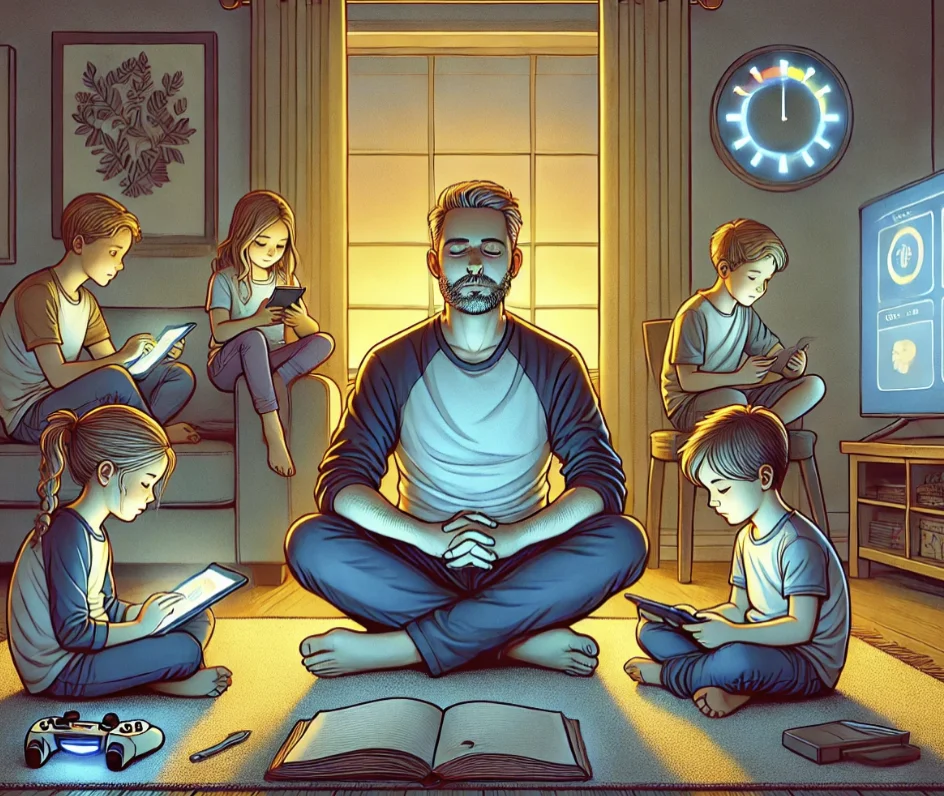At Architects in Music, we often explore how environments shape experiences. In music, design, and beyond. But sometimes, the most important environments are the ones closest to home. As summer approaches, Deniz Alpay reflects on how modern life, technology, and societal rhythms affect him not just as a maker, but as a father of four. What follows is a personal piece / a story of joy that talks about imbalance, and the quiet rebellion of real attention.
Usually, I write here about work. But with summer arriving and the promise of spending more time with my children, I find myself reflecting on things more personal. Not necessarily about work this time, but about me, my thoughts, and how I deal with themes like: “Parenthood, stimulation, and the power of real attention”. I hope you like it!
I’m a true bon vivant by nature. I love good food, beautiful wines, long nights, and celebrating life in all its richness. That used to be normal. Everyone drank, everyone ate meat, and no one talked about dopamine, sugar, or cortisol. But lately, I see more and more people around me quitting alcohol, going plant-based, and leaving parties early. Or even diving into cold plunges, dopamine detoxes, and screen-free retreats. And in that mirror, I suddenly see my own rhythms. Or better said: my habits. And how automatic they’ve become.
I’m not partying every day, not at all. But my lifestyle is definitely built around pleasure and if I’m honest: excess. Not destructively so, but not exactly healthy either. When I go, I go all in. Not to lose myself, but to truly taste, feel, and share life.
Only… moderation has never been my strong suit. And so certain patterns sneak in. Routines that no longer serve, but that just… exist. Automatic. And thus hard to change.
This text is not a plea for sobriety, nor an attack on people who love life. It’s an attempt to name something many of us might recognize, namely the real struggle for health, peace, and balance is often invisible. Not dramatic. But quiet, systemic, and persistent. And it’s not always about personal willpower, but about the environment. Its design. Because what if your environment is designed in such a way that it feeds all your weaknesses instead of supporting your strength?
Addictions by Generation
Generation X grew up in an era of abundance. Fast food, soda, sugar and fat became widely accessible and addictive. Biologically, we’re wired to crave sugar. Our brains evolved in a hunter-gatherer world where sweet foods like fruit or honey were rare and life-saving and triggering dopamine to help us store energy. Now those foods are constantly and intensely available, leaving our ancient ‘sugar switch’ permanently on.
The results are clear: obesity, type 2 diabetes, heart disease, often by age 40.
Millennials then inherited freedom and unlimited access to technology, but also endless choice anxiety. They grew up on MSN, Hyves, Facebook and the first smartphones. What began as a connection gradually turned into comparison. Burn-outs, FOMO and loneliness became standard complaints.
Behind this digital addiction lies another deep biological reflex: as social beings, we’re extremely sensitive to recognition and rejection. In prehistoric times, exclusion often meant death. That ancient reflex still lives in our brains. But now it’s hijacked by platforms that constantly simulate social feedback through likes, comments, and views.
An entire generation has grown up in a permanent state of alertness: Am I visible? Am I liked? Do I belong?
Long-term exposure to these stimuli now shows measurable brain changes. Studies reveal that frequent social media users become more sensitive to both reward and rejection, meaning the brain is basically always ‘on’. Every notification triggers a dopamine hit, but also a stress response.
Over time, this leads to scattered attention, poor focus, and higher risk of mental exhaustion. Scientists now speak of a “popcorn brain”, trained to jump between stimuli, but increasingly unable to concentrate or find real calm.
My oldest son is now 14. Research shows that even teenagers now exhibit structural changes in brain areas critical for emotion regulation and impulse control. In real life, that means many young people already struggle with restlessness, impulsiveness, and overstimulation — before adulthood has even started.
And I think back to those moments I sat him down with Woezel & Pip on the iPad, just so I could “finish something real quick”… Yeah. Captain Hindsight saves the day.
The New Normal?
I worry we’re building a world where no one can concentrate anymore without external tools. Where caffeine, energy drinks, noise-cancelling headphones or half a Ritalin are the only ways to stay on task.
So is that still focus or just a form of controlled survival in a fundamentally broken system? Maybe it’s not the child with the disorder, but our lifestyle’s tempo that’s insane.
The Real Problem
I don’t believe this is about weak willpower. It’s an unfair fight, against systems designed to addict us. This isn’t occasional behavior. It’s an engineered dependency. Food is optimized for sensory addiction. Algorithms are crafted to keep you hooked. Our kids, and we with them, are not fighting laziness or distraction. We’re up against billion-dollar companies with behavioral scientists and data as weapons.
And me?…
As a father of four, I see it every day. The pull toward screens. The distraction during conversations. The restlessness when nothing moves or stimulates. The “I’m bored”always means just one thing.
I wish I could say I always handle it well. But I don’t. I’m part of the system too. Working, scrolling, rushing. My intention is to create space for calm and balance, but that doesn’t just happen. Rituals sound nice in a mindful Instagram post, but in real life they’re hard to maintain. Especially in a world designed to break our rhythm.
Everyone knows that feeling after a holiday in a warm southern country. The slower pace. The clarity. The presence. You eat slower. You breathe. You connect. And then you come home and within a week you’re back in the fast lane, bouncing from task to task like a pinball.
It’s like an addict who spends six weeks in the Scottish Highlands or South African wilderness. Far from triggers, they regain strength. But the moment they return to their old environment. The same city, people, and stressors, so the chance of relapse is high. Not because they’re weak, but because everything still pulls at them the same way.
So Now What?
I don’t think the solution lies in stricter rules, or shame. It lies deeper: context and Environment. No moral judgement, just practical resistance. And it starts with us.
You can’t correct a child for behavior that the system actively promotes. The answer? Sabotage the system, not the child.
Limiting screen time only works if you also remove the triggers. Turn addictive apps to grayscale. Move them off the home screen. Kill notifications or delete them entirely. Not as punishment, but as protection against an environment that targets kids at their weakest moments.
And this applies to me too. I grew up with ads telling me to “Enjoy, but in moderation.” But what does that mean if you hear it every day for years? What is moderation when excess is normalized? Two glasses a week or per day? Habits build fast. And what becomes routine can quietly spiral into more. That’s why changing the context isn’t soft: it’s radical. It breaks the illusion of normalcy.
The Power of Reverse Routines
Alongside reshaping environments, there’s another key: consciously building new rituals. Charles Duhigg, author of The Power of Habit, describes every habit as a pattern:
Cue → Routine → Reward
For example:
Introduce a screen-free “parent–child time” every Sunday afternoon.
- Cue: After brunch
- Routine: Cooking together, talking, playing games, walking
- Reward: Relaxation, connection, fun
You create something simple that competes with the pull of a screen. Not control, but a real alternative. These kinds of rituals don’t just build behaviors. They create experience, presence, and intrinsic motivation. Especially important in a world where screens pre-package everything.
When a child says “I’m bored,” it’s not laziness. It’s often a brain that’s forgotten how to start something on its own.
That’s why experience-based routines work so well. Like:
- A weekly chore in exchange for saved-up reward money → then spending it together.
- One-on-one outings with a parent, no planning, just full attention. Talking, rambling, doing “nothing.”
At first, kids may say: “This is BOOOORING!” But that discomfort is part of it. I believe, perhaps idealistically, that genuine parental attention always wins over a screen. Not in speed or thrill, but in depth.
Maybe not immediately. But after the ‘detox phase’, space opens up. Space for joy, connection, confidence. Whether it’s music, sports, gardening or taking out the trash. It’s not about the task. It’s about the feeling: I matter, even without an algorithm to validate me.
I’m not writing this as an expert. But as a father, a maker, and a person who’s constantly rebalancing and trying again.
I stumble, I try, I reset, but one thing I know for sure: the intrinsic power of shared presence and attention works. For my kids, and for me.
In a world designed to distract, standing still is a radical act. Doing something without sharing, scoring, or measuring it is rebellion. It starts at home, but ripples out into everything I do. Even in my professional field, this theme is growing: creating room for programs and experiences that breathe. Events that don’t just entertain, but connect. Music that doesn’t just fill space, but gives identity.
An architecture of attention.
So yes… I guess this piece was a little bit about work after all. 😉
Maybe it starts with switching off a screen. But in the end, it’s about switching on what truly matters.







